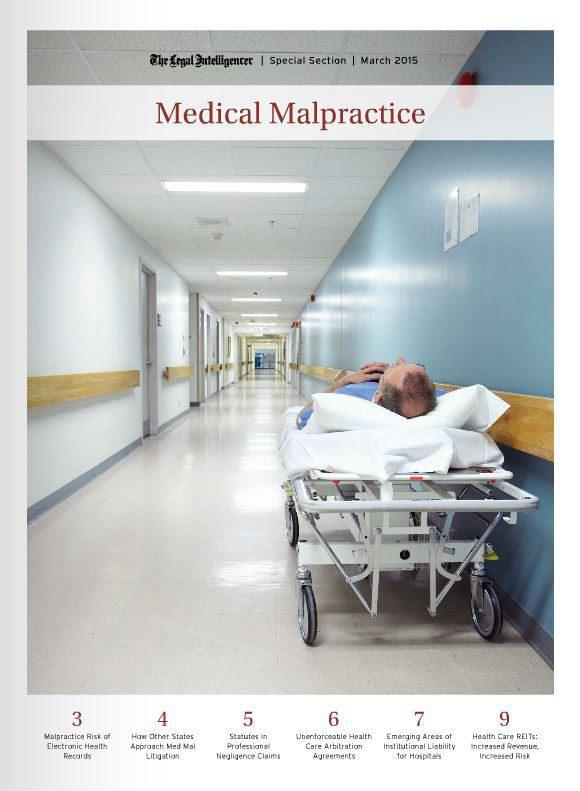Firm-published article: “Emerging Areas of Institutional Liability for PA Hospitals”

This article was originally published in the March 17, 2015 "Litigation: Medical Malpractice" supplement of The Legal Intelligencer, the oldest law journal in the United States.
Until Thompson v. Nason, 527 Pa. 330, 591 A.2d 703 (1991), was decided in 1991, a hospital could only be held liable in a malpractice case under a theory of vicarious liability. Vicarious liability is a tort principle that permits recovery against the institution for the conduct of its agent or employee. Generally, vicarious liability cannot be used for the imposition of punitive damages. Corporate liability is premised upon the concept that the hospital or institution can be held directly liable for institutional or systemic failures and does not require a finding of negligence against an individual agent or employee. The advancement of information technology, including electronic medical records, remote imaging, and the increase in hospital-acquired infections and recognition of the importance of newborn screening have expanded the legal geography for hospital liability under Thompson.
In most hospitals, the staff physicians, hospitalists, and residents are employees of the hospital. Attending physicians frequently are independent contractors and may not be employees of the hospital, unless they hold an administrative or academic position. Absent an employer-employee relationship, vicarious liability and ostensible agency may still apply under the application of corporate liability principles to medical malpractice cases involving hospital care. Under the ostensible agency theory approved by the Pennsylvania Superior Court in Capan v. Devine Providence Hospital, 287 Pa. Super. 364, 430 A.2d 647 (1980), a physician who holds independent contractor status with respect to a hospital may, nonetheless, be an agent of that hospital with respect to a patient, based upon Section 429 the Restatement (2d) of Torts (1965). Two factors relevant to ostensible agency are (1) whether the patient looks to the institution rather than the individual physician for care; and (2) whether the hospital “holds out” the physician as its employee. Simmons v. St. Clare Memorial Hospital, 332 Pa. Super. 444, 481 A.2d 870 (1984). In 2002, Pennsylvania passed the Medical Care Availability and Reduction of Error Act (MCARE) (40 P.S. §§ 1303.101- 1303.910), which among other things, codified ostensible agency in Section 516 (40 P.S. §§ 1303.516). Under §516, a hospital may be held vicariously liable for the acts of another health care provider through principles of ostensible agency if the evidence shows that a reasonably prudent person in the patient’s position would be justified in the belief that the care in question was being rendered by the hospital or its agents, or the care in question was advertised or otherwise represented to the patient as care being rendered by the hospital or its agents.
The theory of corporate liability in Pennsylvania begins with the seminal case of Thompson v. Nason,where for the first time the Pennsylvania Supreme Court held that a hospital can be held directly liable under a theory of corporate liability if it has failed to put in place or follow hospital policies and procedures to ensure the patient’s safety and well-being at the hospital. It is a non-delegable duty the hospital owes directly to the patient. As a result, problems with the delivery of care to a patient involving an electronic medical record, remote imaging, or a hospital-acquired infection could easily implicate both vicarious liability for individual conduct as well as corporate liability as an alternative, but not co-dependent, cause of action. A corporate claim under Thompson v. Nason can be brought at the same time as a traditional claim based upon vicarious liability, and does not fail merely because there was not a finding of negligence by the jury against an agent of the hospital.
Electronic medical records (EMRs) have become increasingly prevalent, and many hospitals utilize software that relies exclusively upon computer-entered data, much of which is entered by providers simply checking boxes “yes” or “no” and selecting from a list of options, resulting in an electronic print-out. An electronic medical record, properly implemented, cannot be later changed without leaving a trail. The EMR should prevent providers from claiming they were unaware of important test results or critical portions of a patient’s medical history regardless of when it was provided, even in an earlier admission, as the EMR should carry it forward. If the EMR does not, or if abnormal test results and drug interactions are not flagged because of a software glitch, the hospital has potential liability on corporate grounds.
Some hospitals use teleradiology services to read and interpret diagnostic studies at night, when their regular radiologist is off-duty. Digital technology enables the hospital to transmit the images anywhere around the world, leading to the use of domestic and overseas radiologists to perform interpretations, and places the hospital itself squarely within the chain of responsibility for the quality of the study and its timely reporting. Most patients know that hospitals outsource certain laboratory tests to third parties, but few patients would think to question the credentials, physical location, or training of a radiologist reading a study. There are some inherent challenges to the quality of teleradiology, including the lack of clear lines of communication between the clinician and a doctor remotely reading the study, who is often overseas. It is also possible that the radiologists interpreting the study are not subject to the same licensing and credentialing requirements of the hospital’s domestic staff. Care decisions and recommendations based upon the faulty interpretation of a study, read off-site, or affected by a transmission, language, or communication problem, should also implicate potential corporate claims under Thompson.
A hospital-acquired infection (HAI), also known as a nosocomial infection, is by definition not present upon admission. HAIs are on the rise due to an increase in multi-resistant pathogens and antibiotic resistant bacteria. Pennsylvania hospitals are required to report any HAI to the Center for Disease Control. In 2011, 254 hospitals reported 22,713 HAIs over 10.2 million patient days (Pennsylvania Department of Health, Healthcare-Associated Infections in Pennsylvania Hospitals, 2011 Annual Report, August 2012). The most common categories of HAIs in 2010 were: surgical site infections, catheter-associated urinary tract infections, and gastrointestinal infections. The six benchmark surgical site infections are: cardiac surgery, cardiac bypass grafts with single incision site, cardiac bypass grafts with dual incision sites, hip prostheses, knee prostheses, and abdominal hysterectomy.
A recent report demonstrates how big the problem of HAI has now become. The report is based on 2011 data from 183 hospitals in 10 states and found that 4% of patients had HAIs, which was 648,000 patients. Of those, 75,000 resulted in death (Magill, S. et al. Multistate Point-Prevalence Survey of Health Care-Associated Infections. N Engl J Med 2014; 370:1198-1208, March 27, 2014). While not all hospital-acquired infections are preventable with good care, and even robust anti-infection policies may fail, many such infections are preventable, including, by way of example, Legionnaire’s Disease. The report of such an infection implicates corporate liability issues since it is almost always from the potable water in a commercial water supply that can be prevented with appropriate disinfection systems.
Similarly, newborn screening is required by state law to screen for certain specific genetic disorders, and if not timely done or reported, may implicate a corporate claim. The Newborn Child Testing Act was amended in 2008, expanding newborn screening practices in Pennsylvania and requiring screening for congenital adrenal hyperplasia (CAH), congenital hypothyroidism (CH), galactosemia (GAL), maple syrup urine disease (MSUD), phenylketonuria (PKU), and hemoglobinopathies (HGB). P.L. 288, No. 36, Cl. 35 (2008). By statute, blood must be collected within 48 hours after birth, and should be sent to a lab within 24 hours. Some disorders can be treated successfully, like homocysteine (HCU), if treatment is started promptly. A frequent problem with newborn screenings is the untimely reporting of results, reporting of results to the hospital instead of the ordering pediatrician, and in some cases the failure of the recipient to notify or timely notify the parents. Pennsylvania requires samples be sent to the lab with 24 hours via 1st class mail and testing labs must be open 7 days a week. If the testing is not done or is done and not timely reported as a result of system error, a corporate claim may be viable.
The advancement of information technology, including electronic medical records, and remote imaging is fundamentally changing the nature of the way healthcare is delivered. These technological changes, combined with the increase in the rates of hospital-acquired infections and recognition of the importance of newborn screening, are ushering in a new era in healthcare that could scarcely have been imagined when Thompson was decided over twenty years earlier but fit squarely within its legal framework.

